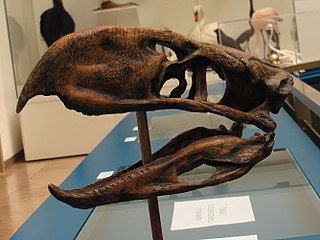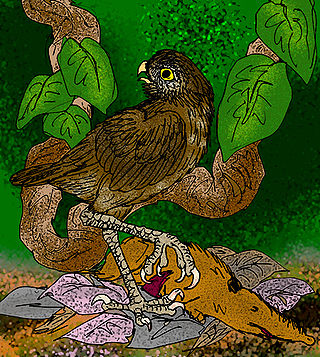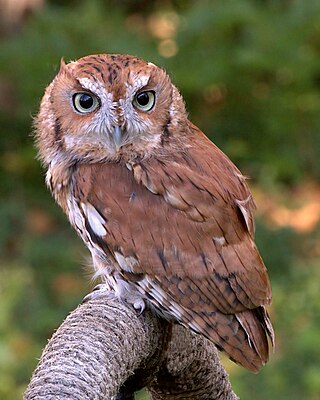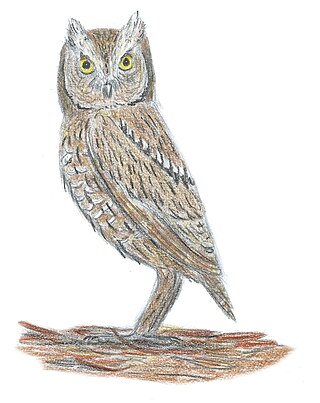
Owls are birds from the order Strigiformes, which includes over 200 species of mostly solitary and nocturnal birds of prey typified by an upright stance, a large, broad head, binocular vision, binaural hearing, sharp talons, and feathers adapted for silent flight. Exceptions include the diurnal northern hawk-owl and the gregarious burrowing owl.

The true owls or typical owls are one of the two generally accepted families of owls, the other being the barn owls (Tytonidae). This large family comprises 230 living or recently extinct species in 24 genera. The typical owls have a cosmopolitan distribution and are found on every continent except Antarctica.

The American horned owls and the Old World eagle-owls make up the genus Bubo, at least as traditionally described. The genus name Bubo is Latin for owl.

Scops owls are typical owls in family Strigidae belonging to the genus Otus and are restricted to the Old World. Otus is the largest genus of owls with 59 species. Scops owls are colored in various brownish hues, sometimes with a lighter underside and/or face, which helps to camouflage them against the bark of trees. Some are polymorphic, occurring in a greyish- and a reddish-brown morph. They are small and agile, with both sexes being compact in size and shape. Female scops owls are usually larger than males.

Phorusrhacos is an extinct genus of giant flightless terror birds that inhabited South America during the Miocene epoch. Phorusrhacos was one of the dominant land predators in South America at the time it existed. It is thought to have lived in woodlands and grasslands.

Tyto is a genus of birds consisting of true barn owls, grass owls and masked owls that collectively make up all the species within the subfamily Tytoninae of the barn owl family, Tytonidae.

Asio is a genus of typical owls, or true owls, in the family Strigidae. This group has representatives over most of the planet, and the short-eared owl is one of the most widespread of all bird species, breeding in Europe, Asia, North and South America, the Caribbean, Hawaii and the Galápagos Islands. Its geographic range extends to all continents except Antarctica and Australia.
Günther Edmund Maul was a German ichthyologist and taxidermist in Portugal. Maul came to Madeira in December 1930 to work as taxidermist at Museu Municipal do Funchal, which opened to the public in 1933. He was appointed director for the museum in 1940, a post that he held to his retirement in 1979. He, however, continued his research until shortly before his death. He started two journals and opened the museum's aquarium to the public in 1959. He also participated in several expeditions including with the French bathyscaphe Archimède in 1966 and organised the first multidisciplinary expedition to the Salvage Islands in 1963. He was awarded an honorary doctorate from the University of Madeira in 1995.

The giant Cuban owl or giant cursorial owl (Ornimegalonyx) is an extinct genus of giant owl that measured 1.1 metres in height. It is closely related to the many species of living owls of the genus Strix. It was a flightless or nearly flightless bird and it is believed to be the largest owl that ever existed. It lived on the island of Cuba.

Screech owls are typical owls (Strigidae) belonging to the genus Megascops with 23 living species. For most of the 20th century, this genus was merged with the Old World scops owls in Otus, but nowadays it is again considered separately based on a range of behavioral, biogeographical, morphological, and DNA sequence data.
Paleontology or palaeontology is the study of prehistoric life forms on Earth through the examination of plant and animal fossils. This includes the study of body fossils, tracks (ichnites), burrows, cast-off parts, fossilised feces (coprolites), palynomorphs and chemical residues. Because humans have encountered fossils for millennia, paleontology has a long history both before and after becoming formalized as a science. This article records significant discoveries and events related to paleontology that occurred or were published in the year 1965.

The Cretan owl is an extinct species of owl from the Pleistocene of the island of Crete, in the eastern Mediterranean. It was first named by Weesie in 1982. In life, it would have been at least 60 cm tall, considerably larger than little owl and appears to have been terrestrially adapted, with relatively short wings and long legs. Its primary prey was likely the endemic mouse species Mus minotaurus, as evidenced by the numerous owl pellets containing it recovered from the caves from which the bones of A. cretensis were found.

Patagornis is a genus of extinct flightless predatory birds of the family Phorusrhacidae. Known as "terror birds", these lived in what is now Argentina during the Early and Middle Miocene; the Santa Cruz Formation in Patagonia contains numerous specimens. Patagornis was an agile, medium sized Patagornithine and was likely a pursuit predator.

Palaeoglaux is a genus of fossil owls from the Eocene epoch. The two known species are P. perrierensis from the Upper Eocene of Quercy, France, and P. artophoron from the Middle Eocene Messel shales, Germany. The holotype of P. perrierensis is a partial left coracoid in the Collection Université Montpellier, accession number PRR 2585. The four paratypes are the distal part of a left humerus (PRR2591), the proximal part of a left ulna, the distal part of a left ulna, and the distal part of a right tarsometatarsus. The type specimen of P. artophoron is a fossil slab and counterslab containing most of the postcranial skeleton and some feather impressions. This specimen is in the collection of the Forschunginstitut Senckenberg, accession number SMF-ME 1144 A and B.
Eostrix is a genus of extinct primitive owls in the family Protostrigidae, along with Oligostrix and Minerva. These owls date from the early Eocene of the United States, Europe, and Mongolia. They have been described based on fossil remains. The genus was created by Pierce Brodkorb in 1971 to place a fossil species known until that time as Protostrix mimica.

The Madeiran scops owl is a small extinct owl that once inhabited the island of Madeira in the Macaronesian archipelago off the north-west coast of Africa in the North Atlantic Ocean.
Bubo osvaldoi, also known as the Cuban horned owl, is an extinct species of horned owl from Pleistocene of Cuba.
Protostrigidae is a prehistoric family of owls which occurred in North America, Europe, and Asia during the Eocene and early Oligocene periods. Genera include Eostrix, Minerva, Oligostrix, and Primoptynx. In 1983, Cécile Mourer-Chauviré demonstrated that Protostrix is a junior synonym of Minerva.
Palaeophasianus is an extinct genus of flightless Geranoididae birds that lived in North America during the Eocene period. Robert Wilson Shufeldt classified Palaeophasianus as a galliform when he described it in 1913. However it was transferred to Cracidae in 1964 by Pierce Brodkorb, while Joel Cracraft in 1968 placed it in Gruiformes.
Asio ecuadoriensis is an extinct species of eared owl from the Pleistocene of Ecuador. Known from bones of the legs, it was a robust predatory bird similar in size to the great horned owl. Based on the robustness of its limbs and the bones found in what may have been its burrow, it's possible that it may have been specialised in hunting other species of owls.












